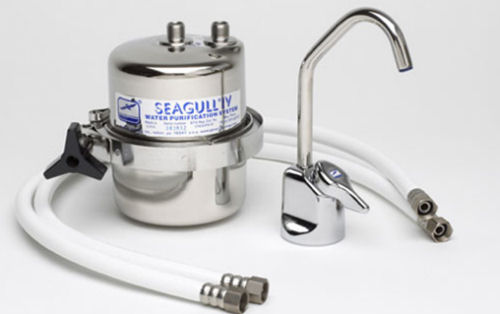Water, Water Everywhere... and Not a Drop Worth Drinking?
If the fresh water coming out of your boat’s faucet tastes like you squeegee’d it off the ship’s cat, don’t take to the bottle. Any fresh water can have contaminants that ruin its taste, and dirty fiberglass tanks will make even the purest water taste like bilge slime. But the solution is easy: Add a treatment system to your freshwater plumbing. Treatment systems range from simple filters to elaborate UV purifiers; filters will work for most of us. They are easy to install and not too expensive, and will have you reaching for a glass, not the bottle.

Heading south for the winter? Life’s great under the warm breezes and swaying palms -- until you get thirsty, anyway: Too often the drinking water in tropical paradises tastes funky. (Maybe that’s why so many folks in the Caribbean drink Mount Gay rum for breakfast.) Protect yourself by turning bad water into something you’ll actually enjoy swallowing with an onboard water-treatment system. A basic but adequate system is both inexpensive and easy to install.
In the U.S., where most drinking water is safe, it still might not taste good. While EPA regulations require all public water systems to reduce concentrations of the most dangerous contaminants, removing other impurities is recommended, but not mandated by federal law. High concentrations of these secondary contaminants, including aluminum, copper, fluoride, “foaming agents,” iron and sulfates, “may cause cosmetic or aesthetic effects,” according to the EPA; in other words, water that meets EPA regulations can discolor your teeth or skin or taste like bilge slime. (For detailed info on water quality, see www.epa.gov/safewater.)
Boat Tank Water
Even if the water coming from the dockside tap is fine, your fiberglass tanks can turn it sour. The problem is exacerbated by algae and other nasties, especially if the water isn’t used and replenished frequently. So step one on the path to pure water is to clean the tanks. Add a cleaner/treatment, like Starbrite’s Aqua Clean (www.starbrite.com), take the boat for a ride to slosh it around, then pump the tank dry through the galley and head faucets. Refill the tank, adding Starbrite’s Water Conditioner to keep the tank and plumbing sweet.
Now add a filter system. Large yachts with many freshwater outlets usually install a large-capacity industrial charcoal filter at the water pump. Boats with dockside pressure-water should have a filter at the inlet, too. In either case a flowmeter will be handy for determining when to change the filter cartridge – a dirty filter is worse than no filter at all.
The Simple Solution
A simpler solution is to install a filter at each faucet, or maybe just one in the galley and one for the icemaker. This is a do-it-yourself job requiring only basic skills and tools: Mount the filter under the sink, where it’s easy to reach for changing the cartridge. Turn off the freshwater pump, disconnect the supply hose from the cold-water faucet, connect it to the filter, then connect the filter to the faucet. Turn on the water and let it run for five minutes to flush away loose charcoal. Have a drink.
Many filter systems include dedicated faucets so you filter only the water you want to drink, extending the life of the (often expensive) cartridge but making installation more complex and often taking up valuable work space around the sink. Unless you drink a lot of water, is this necessary? Most filter cartridges will last an entire season anyway.
Shurflo (800-854-3218; www.shurflo.com) makes good, reasonably priced filters. If you want to spend more for something fancier, check General Ecology’s NaturePure and Seagull IV systems (800-441-8166; www.generalecology.com). Or visit West Marine (www.westmarine.com) where you’ll find a selection of filters, from simple in-line models to more complex systems.
How About U.V.?
If you want the ultimate in water purifying, how about ultraviolet disinfection? Used in conjunction with standard water filters to remove solids and chemicals, a UV water purifier uses the germicidal band of the UV spectrum to kill microorganisms; the filtered water runs through a clear tube where it’s zapped with UV light.
Installing a UV purifier isn’t much harder than installing any filter – water line in, water line out – with the addition of electricity. The Water Fixer (888-699-6166; www.waterfixercompany.com) and Atlantic Ultraviolet (631-273-0500; www.ultraviolet.com) make UV purifiers for both 12v. and 120v. systems. The cost is reasonable: under $500 for a high-flow purifier. How can you afford not to have one?